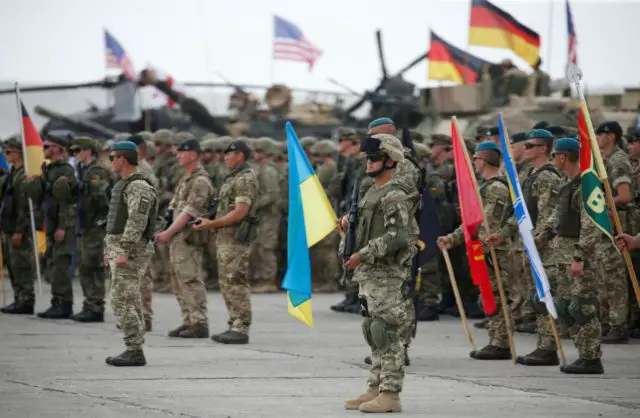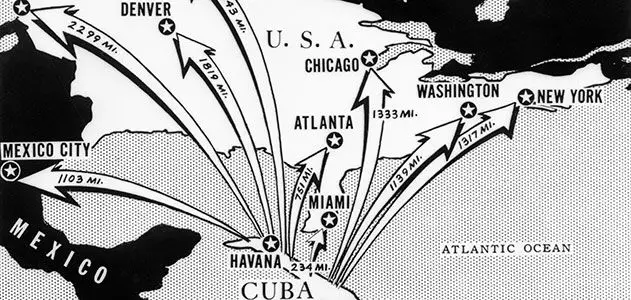If Russia places its missiles in Venezuela or Cuba, some NATO allies will not like it, said the chairman of the NATO Military Committee, Admiral Robert Bauer, on Thursday.
“These are not NATO territories if we talk about Venezuela and Cuba. But I think that there are states, allies that would be concerned about such a development of events,” he said at a press conference, answering a question about a possible NATO reaction in the event of Russia’s deployment of missiles on Cuban and Venezuelan territory.
Earlier on Thursday, Russian Deputy Foreign Minister Ryabkov did not rule out that if negotiations with the West on security guarantees fail, Russia could take measures such as the deployment of Russian military infrastructure in Cuba and Venezuela.
“I do not want to confirm anything, (…) or exclude anything,” he said in an interview with the RTVi TV channel, answering a question about the possibility of such a development of events.
The U.S. action will be decisive
The U.S. reaction to the deployment of Russian forces in Latin America will be decisive, said the U.S. President’s National Security Advisor Jake Sullivan.
“This topic was not raised (in consultations with Russia this week ). If such a deployment occurs, we will react decisively,” he said at a briefing at the White House.
What is the current crisis?
Russia is engaged in a tussle with the U.S. and NATO, given NATO expansion and activities on the Russian borders. Russia is also responding to the deployment of American missiles outside the United States.
On August 23, 2019, Russian President Vladimir Putin instructed the Ministry of Defense “to take exhaustive measures to prepare a symmetrical response” to U.S. plans, including deploying its missiles in the Asia-Pacific region.

“This affects our fundamental interests because all this is located near the Russian borders,” Putin said.
Since then, the Russian side announced their readiness to hand out the U.S. and NATO a ‘very tough response,’ if, during talks on providing security guarantees to Russia, the western representatives refuse to comply with the requirements of non expansion. The deployment of Russian missile weapons near the U.S. borders could likely force Washington to attend to the issue seriously.
In 2010, a Russian Tu-154M aircraft, most likely belonging to the FSB of Russia, was seen in the airspace of Venezuela and Cuba. Who exactly may be on board the special flight and for what purpose the visits to these countries were carried out is unknown. However, experts believe that the Russian side may negotiate to create Russian military bases and facilities in Venezuela and Cuba and deploy missiles. On the other hand, experts draw attention to the fact that other departments should be engaged in solving such problems.
Cuban Missile Crisis – 2
The First Deputy Chairman of the State Duma Defense Committee Alexander Sherin, in 2019, said that the deployment of missiles in Venezuela would lead to a second Cuban Missile Crisis, but sees this as a plus as it was the Cuban Missile Crisis that helped “cool the fervour” of the United States.
Sherin was quoted by Ria Novosti stating, “Unfortunately, the U.S. only understands brute and blunt force. The deployment of our systems in Venezuela, for example, as an option, it can be called the Cuban Missile Crisis – 2, but it was the Cuban missile crisis that cooled the ardour of the United States of America for a long time.”
The deputy expressed confidence that Moscow will be able to agree with Caracas on the deployment of its missiles on the territory of Venezuela since the authorities of both countries are in solidarity in their actions. The deployment of Russian missile systems in Venezuela, according to Sherin, will “multiply by zero” all U.S. efforts to create a missile defense system.
“The flight time and other aspects are incommensurable in terms of capabilities. The capabilities of the Russian Federation will be ten times higher than the capabilities of the entire NATO bloc taken together,” the deputy said.
Caribbean (Cuban) crisis of 1962
The Caribbean (Cuban) crisis of 1962 is a sharp exacerbation of the international situation caused by the threat of war between the USSR and the United States due to the deployment of Soviet missile weapons in Cuba.
With the incessant U.S. military, diplomatic and economic pressure on Cuba, the Soviet political leadership, at her request, in June 1962, decided to deploy Soviet troops on the island, including missiles. (code-named Anadyr).
USSR explained the move by stating that it was to prevent U.S. armed aggression against Cuba and in response to American missiles deployed in Italy and Turkey.
USSR planned to deploy three regiments of medium-range R-12 missiles (24 launchers) and two regiments of R-14 missiles (16 launchers) – a total of 40 missile launchers with a range of missiles from 2.5 to 4, 5 thousand kilometres. A consolidated 51st missile division was formed, consisting of five missile regiments from different divisions to be sent to Cuba.
The total nuclear potential of the division in the first launch could reach 70 megatons. The entire division provided the ability to defeat strategic military targets almost throughout the United States.
USSR also planned to deploy about 44-60 thousand troops in Cuba. The delivery of troops to Cuba was carried out by civilian ships. In July-October 1962, 85 cargo and passenger ships took part in Operation Anadyr, making 183 voyages to and from Cuba.
By October, 47 thousand troops, 24 R-12 launchers, 42 R-12 (SS-4) missiles, including six training missiles, about 45 nuclear warheads, 42 disassembled Il-28 aircraft, as well as military equipment, were transferred to Cuba.
On October 14, an American U-2 reconnaissance aircraft in the area of San Cristobal (Pinar del Rio province) discovered and photographed the build-up of the Soviet missile forces.
On October 16, the CIA reported this to U.S. President John F. Kennedy. On October 16-17, Kennedy called a meeting of his staff, including senior military and diplomatic leaders, to discuss the deployment of Soviet missiles in Cuba. Several options were proposed, including landing American troops on the island, an airstrike on launch sites, and a naval blockade.
In a televised speech on October 22, Kennedy announced the appearance of Soviet missiles in Cuba and his decision to declare a naval blockade of the island from October 24 to bring the U.S. military on alert and enter into negotiations with the Soviet leadership. More than 180 US warships with 85 thousand troops on board were sent to the Caribbean Sea, American troops in Europe, the 6th and 7th fleets were put on alert, up to 20% of strategic aviation was on alert.
On October 23, the Soviet government issued a statement that the U.S. government “takes heavy responsibility for the fate of the world and is playing a reckless game with fire.” The statement did not recognise the deployment of Soviet missiles in Cuba or specific proposals for overcoming the crisis. On the same day, the head of the Soviet government, Nikita Khrushchev, sent a letter to the U.S. President. He assured him that any weapons supplied to Cuba were intended only for defense purposes.

Intensive meetings of the U.N. Security Council began on October 23. U.N. Secretary-General U Thant appealed to both sides to show restraint: the Soviet Union – to stop the advance of its ships in the direction of Cuba, the United States – to prevent a conflict at sea.
October 27 was the “Black Saturday” of the Cuban Crisis. On this day, an American U-2 reconnaissance aircraft was shot down in Cuba, flying over the field positioning areas of the missile forces. The pilot of the plane, Major Rudolph Anderson, was killed.
The President of the United States decided to begin bombing Soviet missile bases and a military attack on the island. Many Americans left large cities, fearing an imminent Soviet strike. The world was on the brink of a nuclear war.
On October 28, Soviet-American negotiations began in New York with the participation of Cuba and the U.N. Secretary-General, which ended the crisis with the respective obligations of the parties. The USSR government agreed with the U.S. demand for the withdrawal of Soviet missiles from Cuba in exchange for the U.S. government’s assurances that it would respect the island’s territorial inviolability and guarantees of non-interference in the internal affairs of that country. The withdrawal of American missiles from Turkey and Italy was also announced in private.
On November 2, U.S. President Kennedy announced that the USSR had dismantled its missiles in Cuba. From November 5 to November 9, the missiles were removed from Cuba. On November 21, the United States lifted the naval blockade. On December 12, 1962, the Soviet side completed the withdrawal of personnel, missiles, weapons and equipment. In January 1963, the U.N. received assurances from the USSR and the United States that the Cuban crisis was over.
